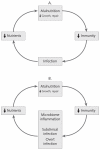Childhood malnutrition: toward an understanding of infections, inflammation, and antimicrobials
- PMID: 25069296
- PMCID: PMC4257992
- DOI: 10.1177/15648265140352S110
Childhood malnutrition: toward an understanding of infections, inflammation, and antimicrobials
Abstract
Background: Undernutrition in childhood is estimated to cause 3.1 million child deaths annually through a potentiating effect on common infectious diseases, such as pneumonia and diarrhea. In turn, overt and subclinical infections, and inflammation, especially in the gut, alter nutrient intake, absorption, secretion, diversion, catabolism, and expenditure.
Objective: A narrative overview of the current understanding of infections, inflammation, and antimicrobials in relation to childhood malnutrition.
Methods: Searches for pivotal papers were conducted using PUBMED 1966-January 2013; hand searches of the references of retrieved literature; discussions with experts; and personal experience from the field.
Results: Although the epidemiological evidence for increased susceptibility to life-threatening infections associated with malnutrition is strong, we are only just beginning to understand some of the mechanisms involved. Nutritional status and growth are strongly influenced by environmental enteric dysfunction (EED), which is common among children in developing countries, and by alterations in the gut microbiome. As yet, there are no proven interventions against EED. Antibiotics have long been used as growth promoters in animals. Trials of antibiotics have shown striking efficacy on mortality and on growth in children with uncomplicated severe acute malnutrition (SAM) or HIV infection. Antibiotics act directly by preventing infections and may act indirectly by reducing subclinical infections and inflammation. We describe an ongoing multicenter, randomized, placebo-controlled trial of daily cotrimoxazole prophylaxis to prevent death in children recovering from complicated SAM. Secondary outcomes include growth, frequency and etiology of infections, immune activation and function, the gut microbiome, and antimicrobial resistance. The trial is expected to be reported in mid-2014.
Conclusions: As well as improving nutritional intake, new case management strategies need to address infection, inflammation, and microbiota and assess health outcomes rather than only anthropometry.
Figures



References
-
- Black RE, Victora CG, Walker SP, Bhutta ZA, Christian P, de Onis M, Ezzati M, Grantham-McGregor S, Katz J, Martorell R, Uauy R, Maternal Child Nutrition Study Group Maternal and child undernutrition and overweight in low-income and middle-income countries. Lancet. 2013;382:427–51. - PubMed
-
- Black RE, Allen LH, Bhutta ZA, Caulfield LE, de Onis M, Ezzati M, Mathers C, Rivera J, Maternal Child Undernutrition Study Group Maternal and child undernutrition: global and regional exposures and health consequences. Lancet. 2008;371:243–60. - PubMed
-
- Garenne M, Maire B, Fontaine O, Briend A. Distributions of mortality risk attributable to low nutritional status in Niakhar, Senegal. J Nutr. 2006;136:2893–900. - PubMed
-
- Guerrant RL, Schorling JB, McAuliffe JF, de Souza MA. Diarrhea as a cause and an effect of malnutrition: diarrhea prevents catch-up growth and malnutrition increases diarrhea frequency and duration. Am J Trop Med Hyg. 1992;47:28–35. - PubMed
Publication types
MeSH terms
Substances
Grants and funding
LinkOut - more resources
Full Text Sources
Other Literature Sources
Medical
Research Materials

